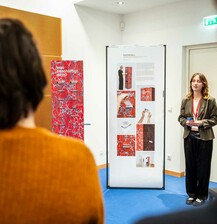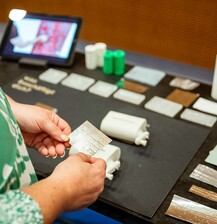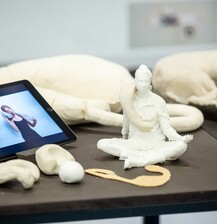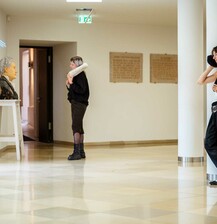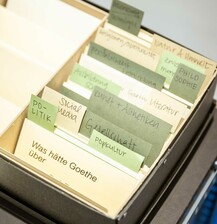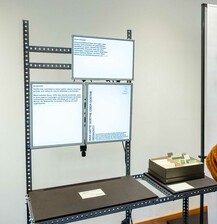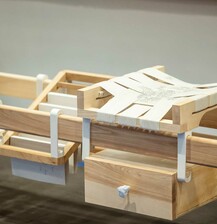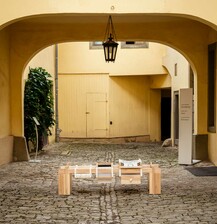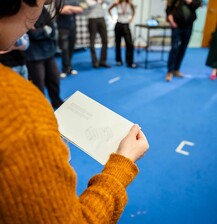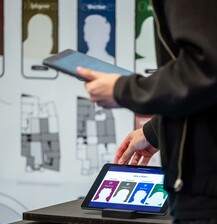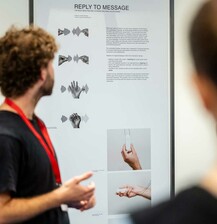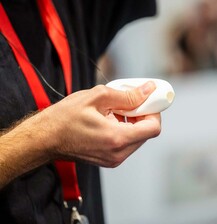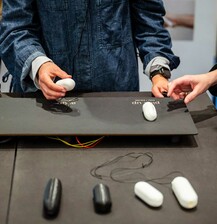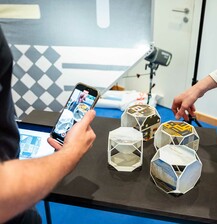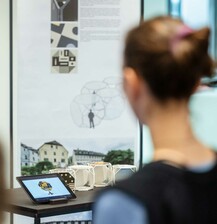Sommersemester 2025, BA/MA Produkt-Design Exzellenzcluster , Produkt_Startseite
Knowledge in Place
— New Objects, Spaces, and Interactions for Knowledge Sharing in Museums
---
The studio project ‘Knowledge in Place’ is researching how museums can remain relevant in a digital world and respond to the needs of today‘s visitors. In cooperation with the Klassik Stiftung Weimar, product design students from weißensee school of art and design developed concepts for new objects, spaces and interactions that convey knowledge in an inspiring and personalised way. The concepts and prototypes are being developed in the context of the re-design phase of Goethe’s residence in Weimar.
--------
Museums are more than just places for sharing knowledge. They offer immersive, one-of-a-kind experiences and serve as important social spaces for connection and community-building. They allow visitors to discover new perspectives, engage in dialogue, and explore knowledge in meaningful and inspiring ways. At the same time, museums are increasingly challenged to remain relevant in a world where information is often accessed digitally and in decentralized ways.
Expectations around learning have shifted significantly in recent years. People now seek more personalized, interactive experiences and the freedom to dive deeper into topics that interest them. They want content that responds to their individual needs and allows for self-directed exploration. So, what does this change mean for museums and their role as spaces of learning?
This question was the central focus this project course undertaken by product design students. Their goal was to develop scenarios and interaction design concepts for the museum space. What new (digital) tools, layers, and approaches to knowledge transfer can we bring into museums? How can we guide visitors through exhibitions while also creating opportunities for individual exploration and personal connections?
Throughout the project, the holistic experience of a museum visit remained a key consideration. Experiencing and interacting with physical objects is a fundamental component and a unique strength of museums. Particularly in the context of knowledge transfer, multi-sensory interaction holds great potential, especially when it involves physical objects and tangible interfaces. Active interaction with the hands not only strengthens haptic and spatial perception but also promotes cognitive processes and is closely linked to our thought processes. Furthermore, physical interfaces enable a multi-layered intake of information that goes beyond visual and auditory stimuli, incorporating tactile and kinesthetic experiences.
The cooperation with the Klassik Stiftung Weimar, and particularly thanks to the input and feedback from the foundation’s experts, ensured a practice-oriented concept development and design process. Goethe’s residence and the Klassik Stiftung’s digital collection provided the thematic framework for the project.
-------
Students:
Giuliano Wai Ging Sammarro, Lara Bartos, Leif Asmus, Lion Votteler, Luica Wendt, Nicolas Roseng, Sándor Lakatos, Sara Winter, Tiana Borcherding
Supervision and Workshops:
Prof. Thomas Ness, Rike Glaser, Jörg Hugo, Simon von Schmude, Yolanda Leask
Product Design, Perspective Interaction
In cooperation with Klassik Stiftung Weimar
summer term 2025
On the foundation's side, the cooperation was supported by Dr. Dirk Wintergrün, Kristina Johannes, Annika Schlimm, and Ira Klinkenbusch."
This project is part of the MoA Design Research Studio of the Cluster of Excellence „Matters of Activity.“
